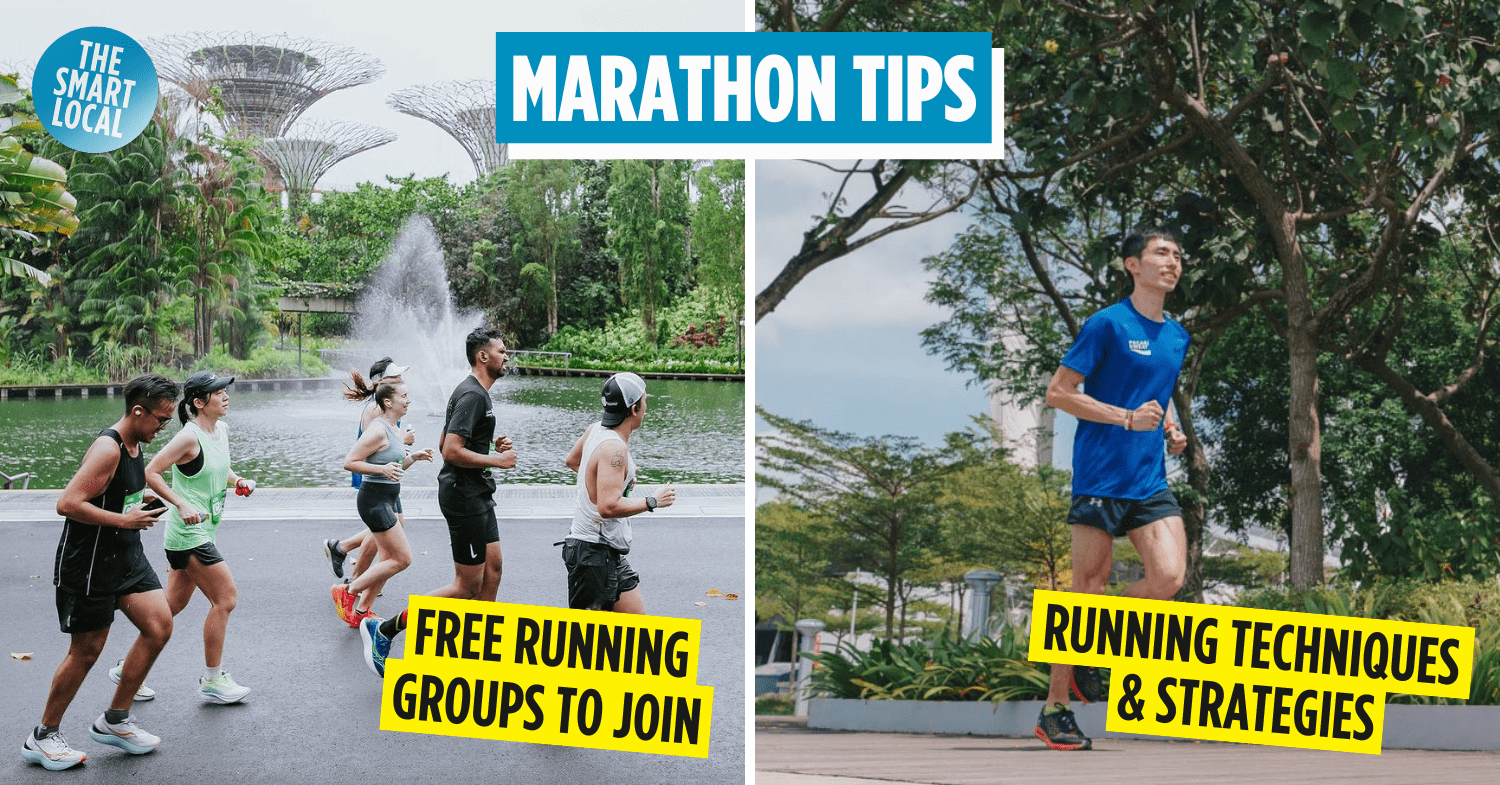Guide to running a marathon
We probably saw the 2.4km runs we were forced to complete in school as the longest 6 laps of our lives. Add another 40km, and you’ve got yourself a full-length marathon. Though, there’s nothing to worry about if you’re running your first race. Here’s a marathon training guide, including first-timers’ tips, exercises, and a workout plan.
How long is a marathon?
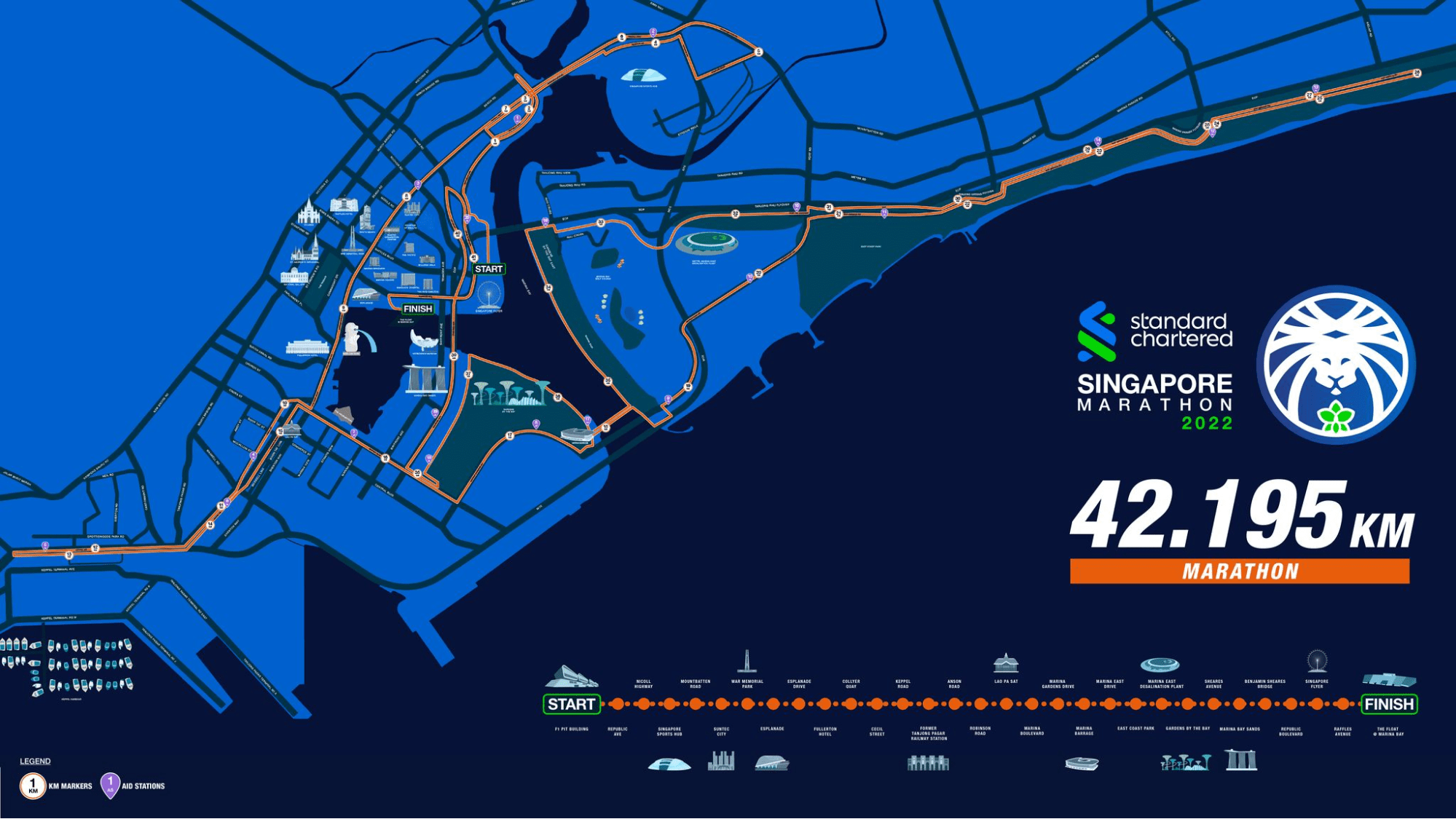 Full route for the SCSM 2024.
Full route for the SCSM 2024.
Image credit: Standard Chartered Singapore Marathon via Facebook
The total distance for a marathon is 26.2 miles; for my fellow metrics users, it’s 42.195km.
Before we get technical, a little fun fact: this distance dates back to the 1908 London Olympics, when, to accommodate the King of England, the race would start at Windsor Castle and end at the Royal Box in the Olympic Stadium. It was officially accepted as the standard length for all marathons during the 1924 Paris Olympics, though it was never explained why.
How fast do marathon runners run?
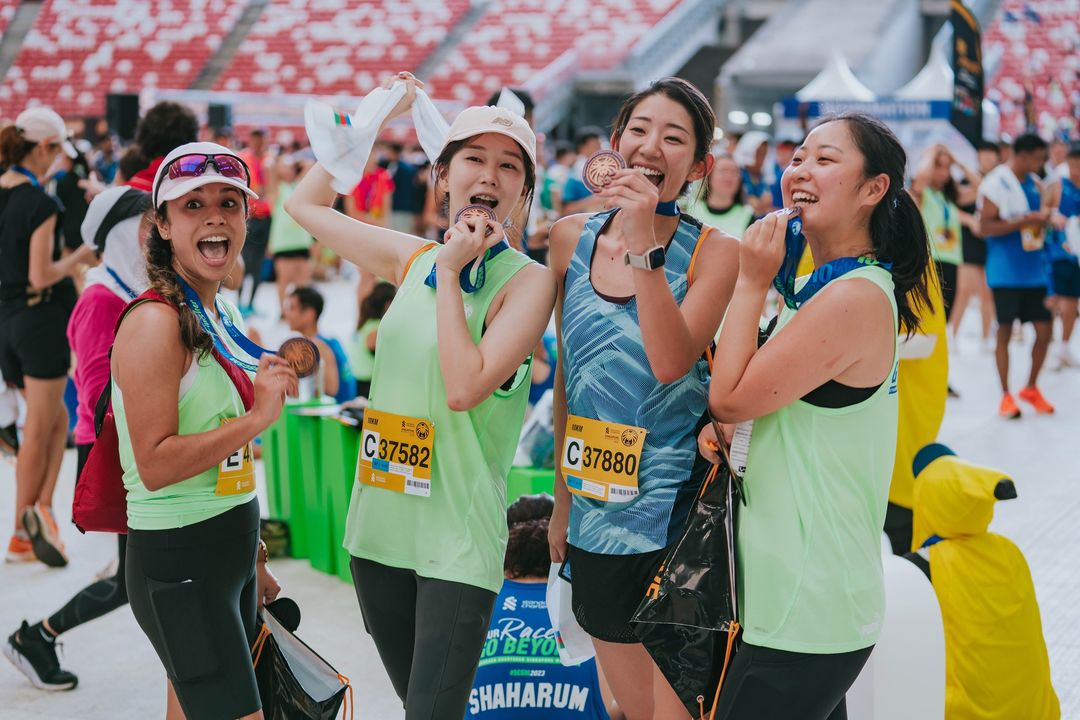
Image credit: @sgmarathon via Instagram
Competitive runners usually complete the race in 2.5 to 3.5 hours, while leisure runners take anywhere from 4 to 6 hours. On average, the cut-off time for men is 4 hours 20 minutes, while women finish the run in 4 hours 45 minutes. This sets the pace for both genders at 6.10 min/km and 6.45 min/km, respectively.
What is a good pace for a first-time runner?
Assuming that you’ve been training consistently for 3 months and running at least 3 times per week, first-time runners can aim to finish a marathon in 6 hours, averaging a pace of 8.30min/km.
What are some of the rules of a marathon?
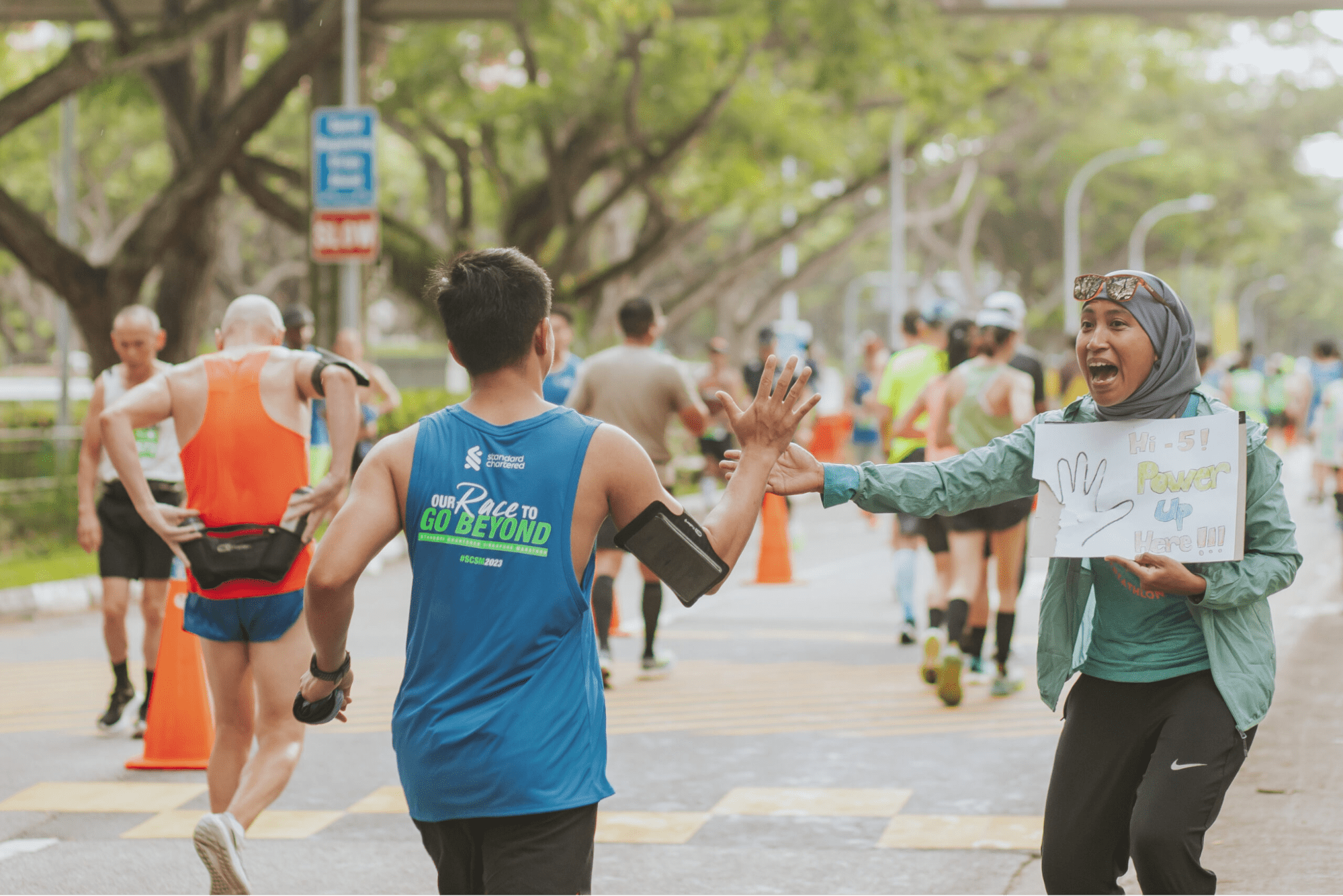 Image credit: Singapore Marathon
Image credit: Singapore Marathon
Can I walk, take a break, or drink during a marathon?
Yes, walking is allowed during a marathon. Craft pockets of time for toilet breaks, water points, and slowing down to snack.
Some runners also adopt a jog-walk strategy during the race. Walking breaks act as a reboot so the body can recover from fatigue and muscle soreness; our heart rate and blood pressure can also return to its normal levels. In this way, runners can conserve energy for the whole race and maintain a consistent pace.
Is there a cut-off time for the race?
Most marathons have a cut-off time at the 7-hour mark, which averages a pace of 9.57min/km. This gives most runners more than enough time to complete the race.
Can someone get disqualified from a marathon?
Unless you’re racing competitively, there are no hard and fast rules if you’re merely running recreationally. All’s well as long as you stick to the designated routes and don’t tamper with your race bib; the chip is usually attached at the back to track your timings.
The night before the run, you can also head to the organisation’s website or social pages to check if there are any items you shouldn’t bring. Anyway, you’ll want to pack as light as possible.
Annual marathons in Singapore
Standard Chartered Singapore Marathon – December
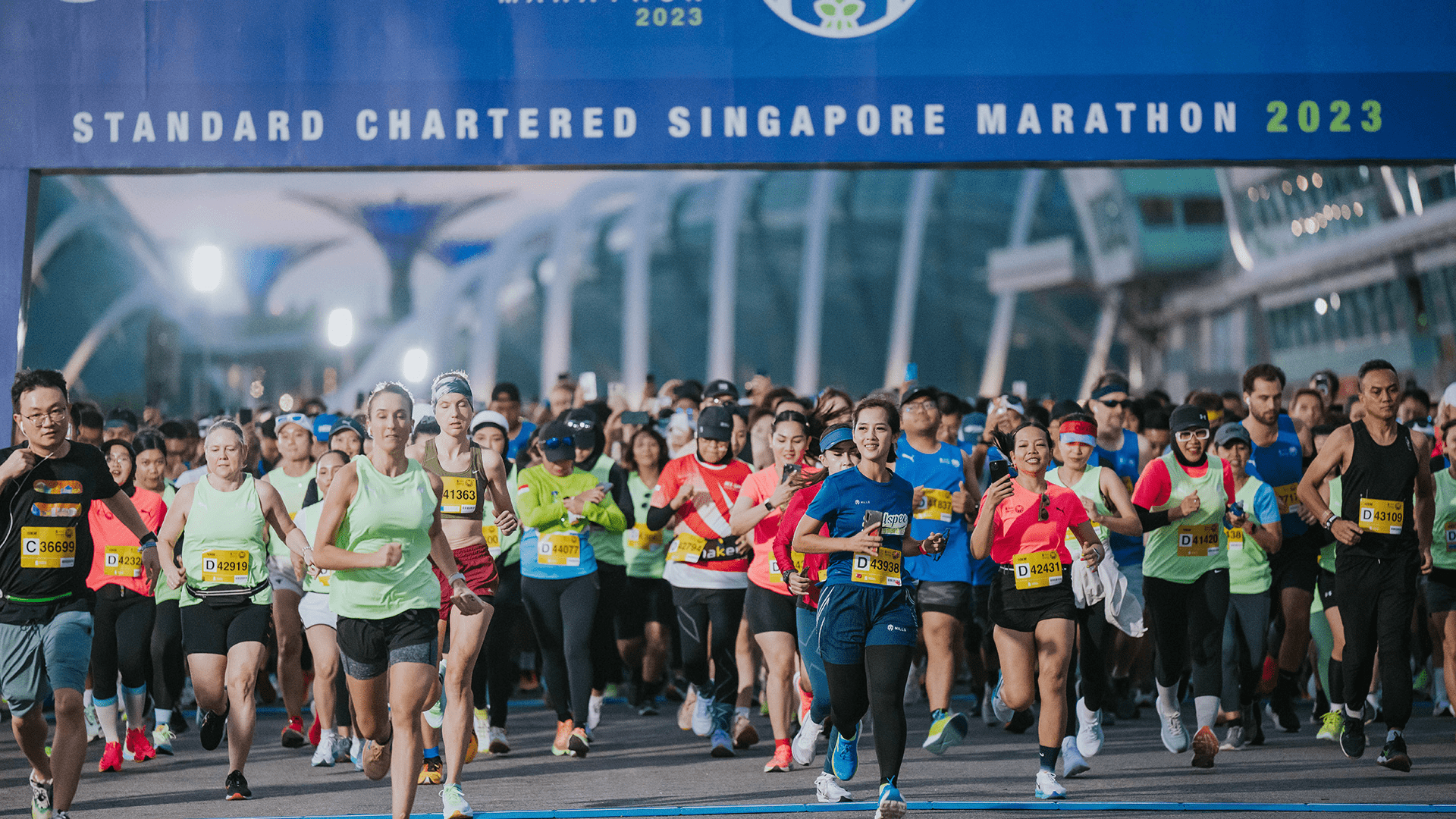 Image credit: Singapore Marathon
Image credit: Singapore Marathon
The Standard Chartered Singapore Marathon is an annual international marathon race and Southeast Asia’s only world athletics gold-label race. It takes place on the first Sunday of December, and participants can register for the marathon, half-marathon, 10km, or 5km categories.
Other runs are the Kids Dash, a 600m or 900m race for those aged 12 and under; Ekiden, a 5-person marathon relay race; and the Double Up Challenge, which involves running 2 races on 2 consecutive days.
Find out more about the Standard Chartered Singapore Marathon.
Great Eastern Women’s Run – October
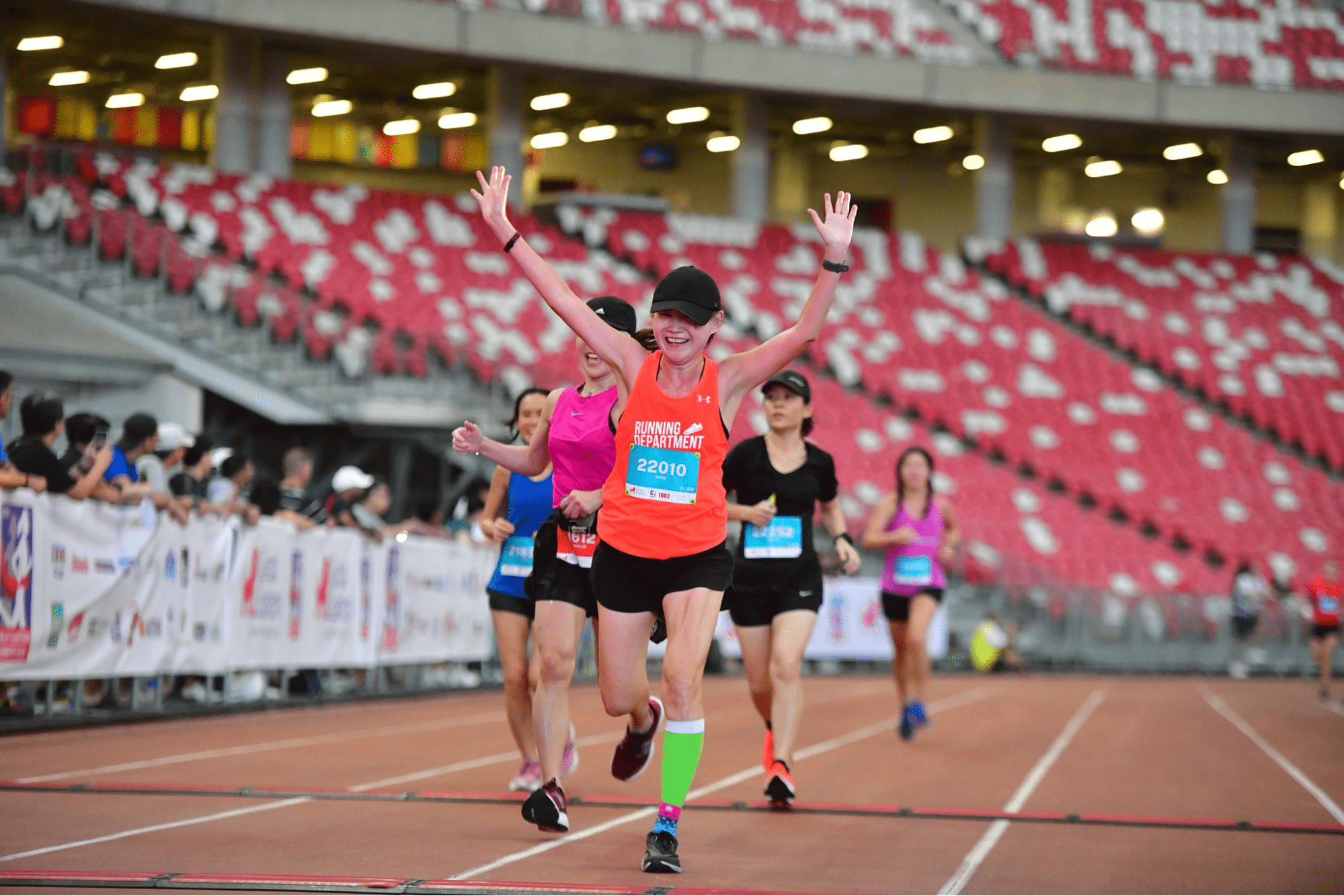 Image credit: Great Eastern Women’s Run Singapore via Facebook
Image credit: Great Eastern Women’s Run Singapore via Facebook
The Great Eastern Women’s Run is an all women’s run that promotes women’s health and wellness. The race usually collaborates with a charity, so you can donate to a greater cause during registration. This year, they’re adopting Daughters of Tomorrow – an initiative to empower women through employment – and the Singapore Cancer Society.
Participants can sign up for the half-marathon, 10km, or 5km race and are entitled to Under Armour t-shirts and a puffy bag.
Find out more about the Great Eastern Women’s Run.
2XU Compression Run – April
In addition to selling world-leading performance compression gears, 2XU hosts the Compression Run during the first half of the year.
Runners can sign up for the half marathon, 10km, or 5km category. Entitlements include a 2XU singlet, polo t-shirt, medal, and tote bag.
Find out more about the 2XU Compression Run.
Preparing for a marathon as a first-timer
Completing a full marathon may seem like a far stretch, especially for those who haven’t tried it before. This begs the question why people join marathons in the first place. It’s not an easy feat for sure, so some take it on as a challenge to improve their overall physical well being.
The arduous routine also trains perseverance and mental strength. In addition, Marathons are often tied to a charity, and running for a good cause is a huge deciding factor for many to even register for one.
And then there are those who simply love running, or collecting event tees, or got forced by friends to join. Whatever your reason for signing up, if you’ve decided to take on a marathon, it’s essential that you prepare and train in the months leading up to the run.
The basics of training to run long distances
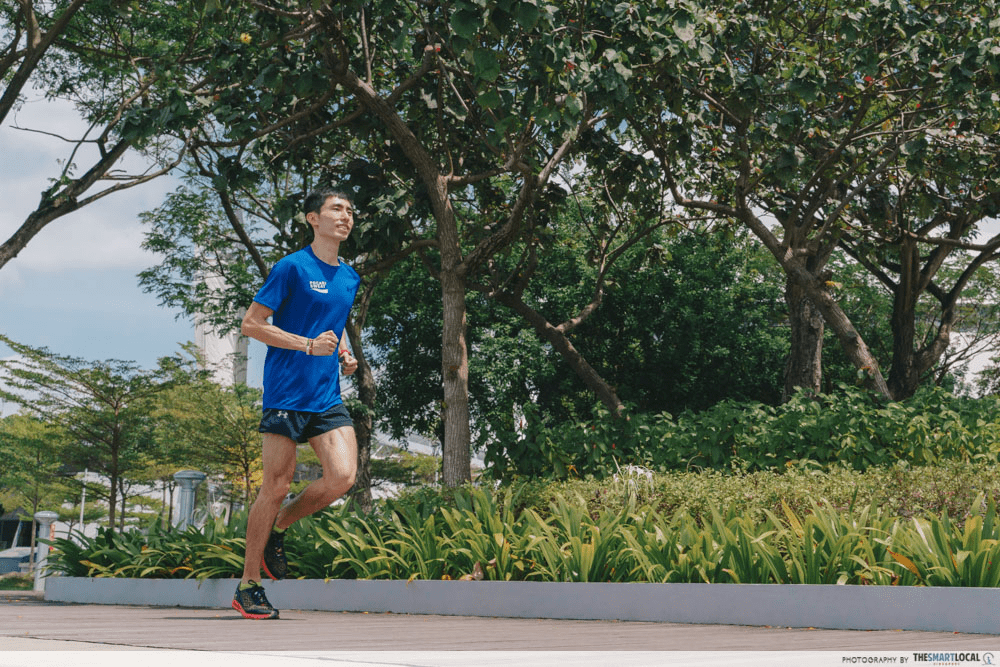
Before embarking on your running journey, here are some basics every first-time marathon runner should incorporate into their runs.
- Base mileage is how long your runs are before stopping. Building a good base is vital before starting a training routine. For beginners, a 3km to 5km run is a good place to start. You want to get used to running longer distances, and the key is steadily increasing your mileage each week.
- Running cadence measures the number of steps taken per minute during a run. The aim is to lessen the time the foot is in contact with the ground, reducing pressure on the joints and muscles. The ideal among athletes is 180 steps/min.
- You’ll notice that heel-striking is one thing all runners try to avoid while running. Landing on your heel puts pressure on your knees and hips, which may cause long-term effects. Landing using the middle or ball of your foot allows for a more efficient energy transfer and reduces the risk of injuries.
Different running routines
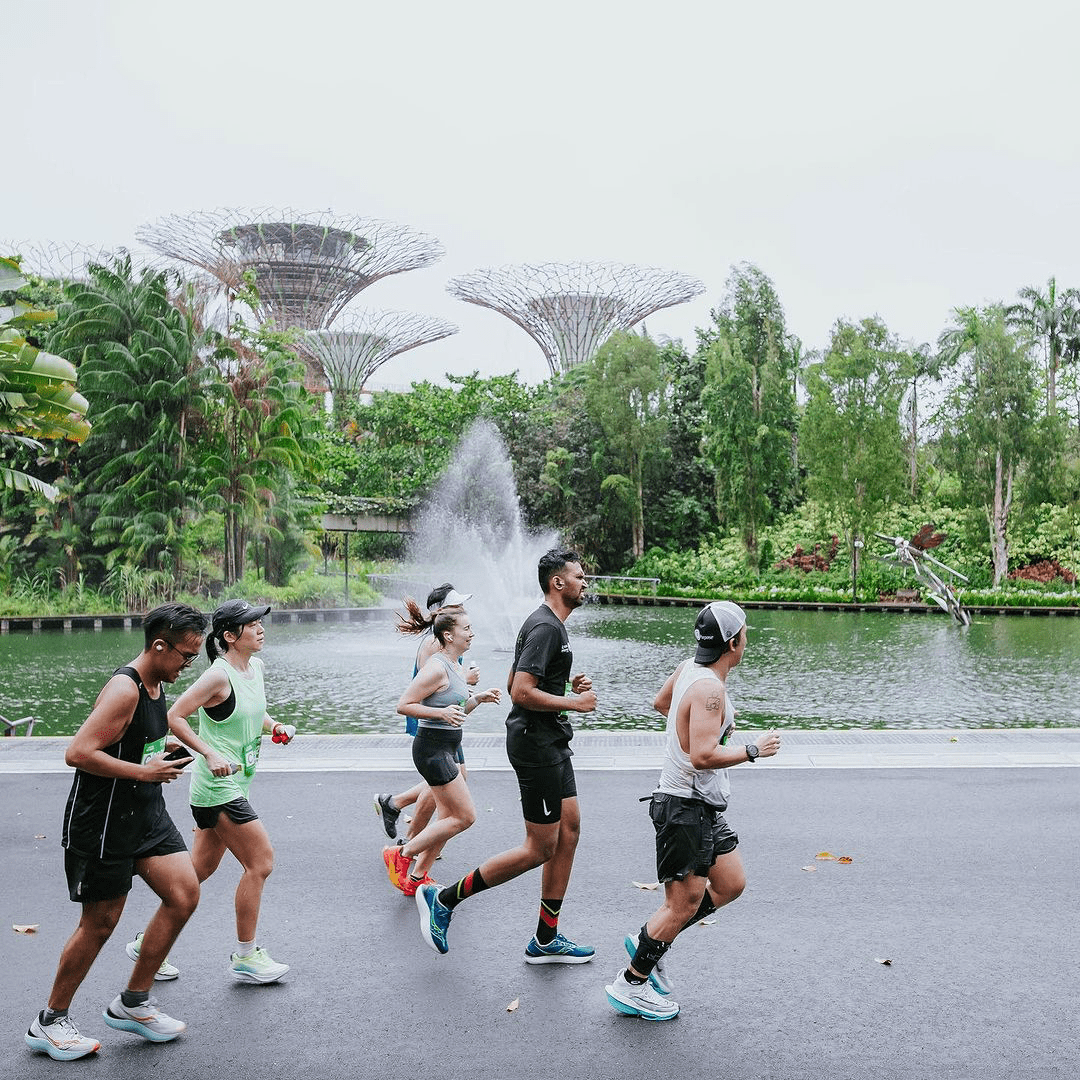
Image credit: @sgmarathon via Instagram
When training, incorporate different routines that target your pace and stamina.
Long runs are the most important part of marathon training, building endurance, stamina, and pacing. You should do these at least once a week, and you can measure your running distance as 20% to 25% of your weekly mileage. Let’s say you’re completing 20km per week; then, you should clock in at least 4km for your long runs.
Next up are the good ol’ speed runs. They help you run faster with ease and build strength, improving your overall timing. There are many forms of exercise for speed runs, but for the sake of our routine, we’ll focus on intervals, uphill workouts, and Fartlek – running continuously at different paces.
Pushing ourselves is how we get stronger, but knowing how to listen to our body is equally as important. Recovery runs are short and slow-paced, usually done after an intense run day to help recover our muscles. As a rule of thumb, you should be able to converse comfortably during your recovery runs without going out of breath.
You can’t exercise 24/7, so remember to alternate your intense run days and take rest days in between. You can also train other muscle groups by hitting up one of the 24-hour gyms or signing up for a cool-down yoga class to stretch those muscles.
Rough training plan 3-6 months before the marathon
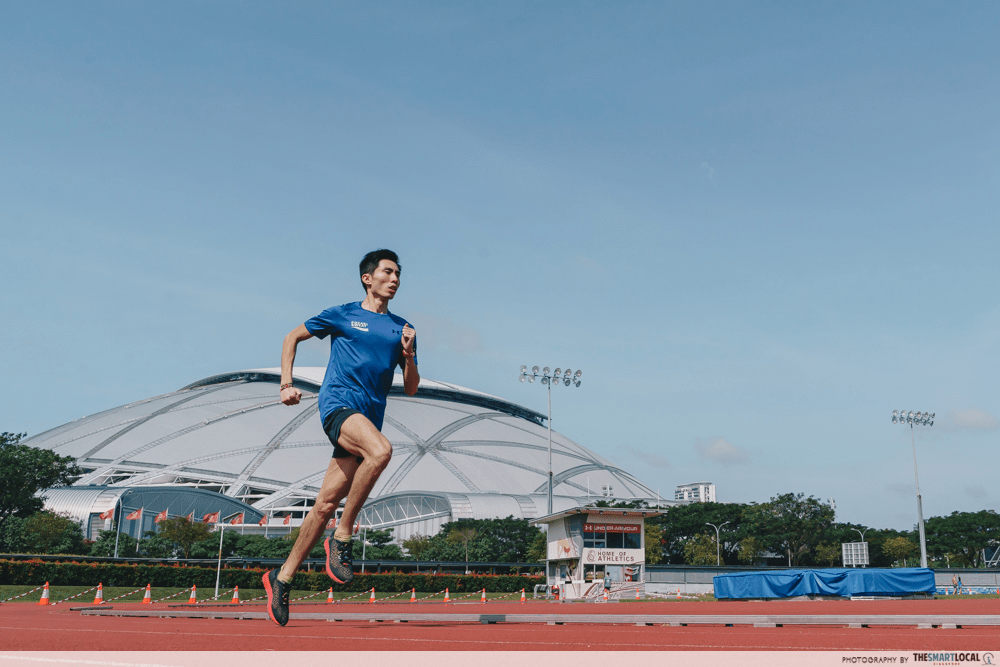
Now, you can’t just wake up one day and say, “I want to run a marathon,” and expect to complete it with ease. Give yourself a window of 3-6 months to train. We want to make sure our bodies are well adapted to running long distances and can keep up with the toll of a marathon, especially for first-timers.
For the sake of busy people like me and you, we’ve drafted a rough 16-week training plan to ease ourselves into our first marathon. Note that this is just a general guide and not a foolproof plan; you should still figure out what works best for you and what fits your schedule.
| 4 weeks | Base mileage of 20km-30km per week
|
| 8 weeks | Base mileage of 30km-40km per week
|
| 12 weeks | Base mileage of 40km-50km per week
|
| 15 weeks | Base mileage of 50km-60km per week
|
| Race week |
Focus on resting a few days before the race so your muscles can recuperate. |
*Base mileage to increase by 2km each week.
To run a Fartlek set, run 5 minutes and rest 2.5 minutes; run 4 minutes and rest 2 minutes; run 3 minutes and rest 1.5 minutes; run 2 minutes and rest 1 minute; and finally run for 1 minute.
Finding motivation to stay on track

Image credit: @sgmarathon via Instagram
You’ve paid money for the race, so you might as well commit to it. Marathons aren’t the cheapest, so get up and go for a little jog to get your money’s worth.
Another no-brainer motivation tactic is to train with friends. Hold each other accountable and set fixed running schedules so you can prepare for those days. You could even plan routes to a new cafe you guys have always wanted to try out or run along the beach during sunset. It’s probably the one instance where peer pressure does wonders.
Running the same route over and over again will get boring, so spice up your training plan with a change of scenery. If your weekday schedule doesn’t permit, try out new routes during your weekend, longer runs. You’ll have your surroundings to distract you instead of the same 20-plus laps at the stadium.
Smaller, realistic goals are the key to success. Don’t strive to run 20km immediately and get disheartened when you don’t hit your mileage. It’s easier to complete tiny achievements and feel rewarded on more occasions.
Running groups to join in SG
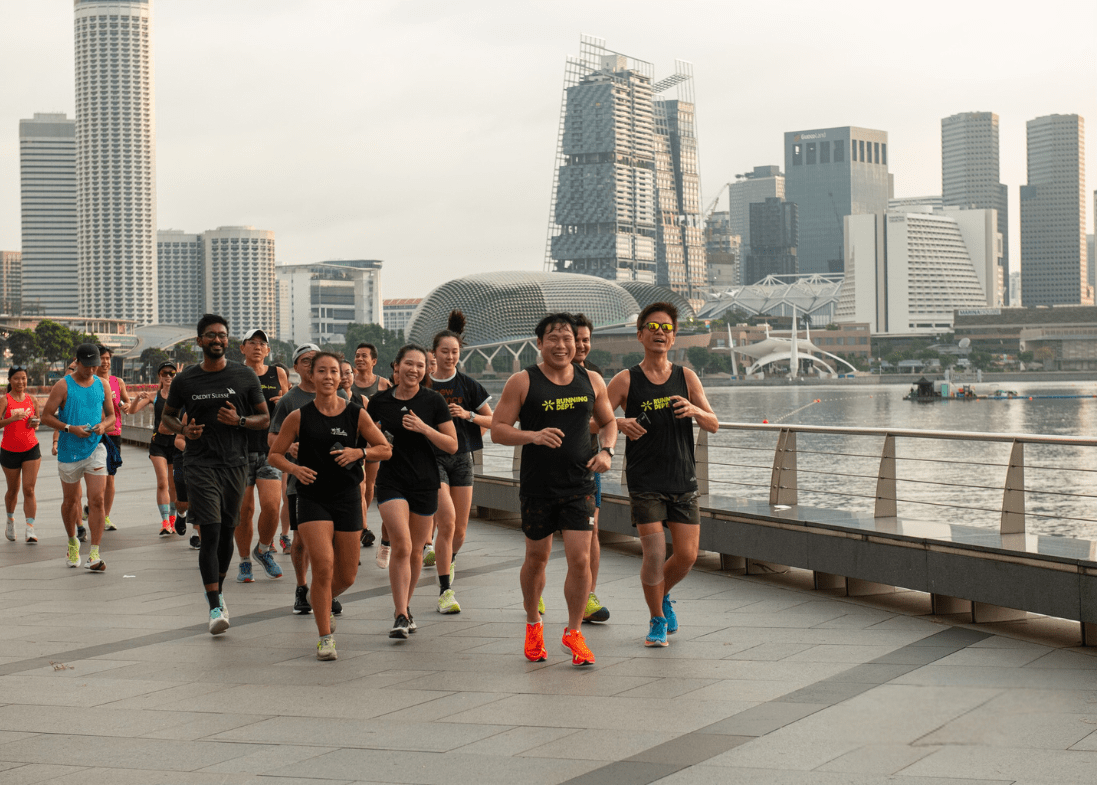
Image adapted from: Running Department via Facebook
Speaking of finding motivation, a good way to get yourself up and running is to join a run club. I know it might sound intimidating. Those were exactly my thoughts, but trust me, everyone’s incredibly welcoming, and you’ll fit in A-OK. There’s a sense of community when moving with fellow runners; plus, you get to feed off each other’s energy.
The best thing is that running clubs in Singapore are usually free to join. Weekday runs are at night to cater to working adults’ schedules, or if you’re an early bird, there are also weekend morning runs to sign up for. The groups typically have different distances and pacers to guide, so join the ones you’ll be comfortable with.
| Running Group | Meeting point | Schedule | Contact |
| Singapore Runner Club | SUTD sports stadium | Monday, 8.30pm | Singapore Runner Club IG |
| Bukit Gombak stadium | Wednesday, 7.30pm | ||
| Running Dept | UOB Plaza, Raffles Place | Wednesday, 7pm | Running Dept IG |
| Asics Running Club | Singapore Indoor Stadium | Tuesday, 7pm | Asics Facebook |
| Super Hero Runners | OCBC Square, Kallang Wave Mall | Tuesday, 6.45pm | Super Hero IG |
| The Social Running Club | Various locations | Saturday, 7.30am | Social Running Club telegram |
| Adidas Runners Singapore | Asian Civilisations Museum | Thursday, 7pm | Adidas Runners Facebook |
| Various locations | Saturday, from 6am | ||
| Puma Nitro Run Club Singapore | Kallang Wave Mall
PUMA flagship, 313@somerset Vivocity boardwalk |
Thursday, 7pm
Last Saturday of each month, 7am |
Puma Nitro Run IG |
| Volt Runners SG | Vivocity, Nike | Thursday, 7pm | Volt Runners Facebook |
| XTrailBlazers | Carpark behind Sports Hub Library | Tuesday, 7pm | XTrailBlazers IG |
| Marang Road Carpark | Thursday, 7pm | ||
| Multiple locations | Saturday, 6.45am | ||
| Fast and Free Run Club | 100Plus Promenade | Thursday, 7pm | FFRC IG |
| 18 Robinson | Saturday, 6.30am |
What to pack & wear for a marathon

Most runners wear the race shirts provided.
Image credit: Singapore Marathon
Good attire affects performance, so you want to make sure you’re decked out in the appropriate running gear.
The most important thing has got to be the shoes. You should already be training in comfortable running shoes, so stick to those for your race. Your kicks should have good cushioning, breathability, and stability. Here are a few top choices to check out:
| Shoes | Highlights | Price | Where to get |
| Nike Alphafly 3 | Lightweight, heel-to-toe midsole | $399 | Buy it on Nike |
| Saucony Endorphin Pro 4 | Good for heel-strikers | $319.47 | Buy it on Amazon |
| Hoka Clifton 9 | Light and responsive midsole foam | From $160 | Buy it on Running Lab |
| Puma Velocity Nitro 3 | Dual-density midsole | From $84.17 | Buy it on Amazon |
| New Balance Fresh Foam X 880v14 | Good arch support | From $198.33 | Buy it on Amazon |
| ASICS Gel Nimbus 26 | Cushioned foam suitable for long distances | From $227.16 | Buy it on Amazon |
Either regular or compression socks are fine. Ankle socks may be cool in school but not for a marathon, so try to get socks that are longer and cover up until your shin. This helps prevent the back of your heel from rubbing against your shoe.
Wear breathable clothing. You want something quick-drying, so stick to polyester and nylon instead of cotton shirts. Most marathons give participants racing singlets or shirts that runners like to wear, so that’s an option as well.
@kylie.atea Packin the goodz 😍⚡️ #runnerslife #runners #runnersofinstagram #runningtiktok #runningchallenge #runningtiktokmotivation #running #2023runninggoals #runningtiktoker #runningtips #runnerstiktok
As far as packing goes, you want to pack light. That means only bringing the essentials to keep you going throughout the run.
A running vest or running belt is great for marathons because you can carry it over your shoulders or around your waist so your hands can be free. Some runner vests also double as a hydration bag so you won’t have to bring a water bottle with you. You can easily purchase these gears from any sports shop, like Decathlon.
Here’s a list of essentials you may want to bring with you:
- Phone
- Spare cash
- Race bib
- Identification card: If you’re afraid of losing it, you should be allowed to use Singpass on your phone.
- Headphones: Most marathon runs allow listening to music, but check with the organisers beforehand. Wireless or bone-conduction headphones are recommended so they won’t fall off or swing around.
- Anti-chafing products
- Sunscreen, cap, and sunglasses
- Snacks or water: There will be stations handing out small snacks and water so this is optional, but you can pack a few energy gels just in case.
- Small towel
- Change of clothes for after the run
Beginner tips for marathon day

- Wear a comfortable pair of running shoes, preferably the same one you’ve been training with. You can even get a professional shoe fitting at the store. Having a good pair of shoes improves your performance and prevents blisters and injuries. TL;DR: Never, ever run a marathon in a brand new pair of shoes. You gotta make sure they’re nice and seasoned.
- Even if you’re not a breakfast person, eat a little. You don’t want to run on an empty stomach, especially at such long distances. So, fuel yourself with carb-heavy foods and leave some time to digest, preferably at least 2 hours before the run.
- Stick to eating safe foods a week before the race, AKA don’t risk trying new stuff in case of tummy aches.
- Chafing is common during long-distance runs as the skin continuously rubs together, so apply lotion or vaseline to exposed areas before the race.
- It’s easier said than done, but always start slower or at your training pace. The adrenaline and runners around might lead to quicker paces at the start. It’s essential to keep at a comfortable pace to maintain the whole run instead of burning out halfway through.
- A marathon is 42.2km; but that doesn’t mean you have to complete it in one shot. Instead, break your runs up in sections, like 5km or 10km intervals, followed by a 1-2 minute quick walk. You’ll have more motivation to finish a short run than one long stretch.
Running a marathon for the first time
It’s always the first step, or in this case, the first run, that’s the hardest, so big kudos to all of you out there training for a marathon. Whether you’re a beginner runner or have run countless races before, focus on the process and enjoy it. You’ve got this!
For more exercise reads:
Cover image adapted from: @sgmarathon via Instagram
